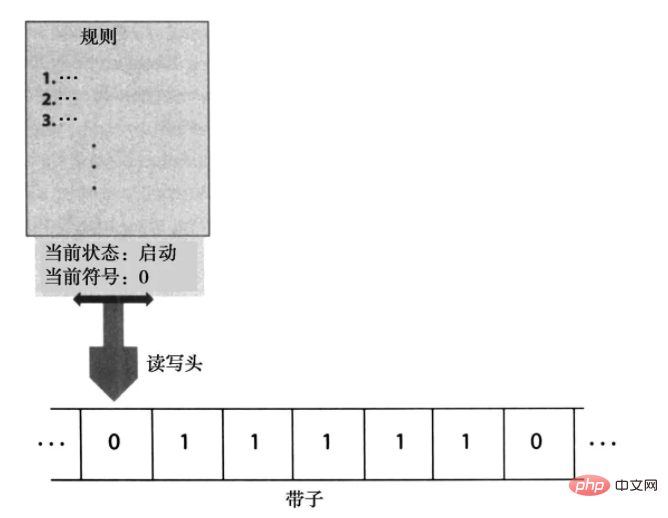What three parts does a Turing machine consist of?
Turing machine consists of three parts: 1. A tape, which is divided into many squares, into which symbols can be written or read; 2. A movable read-write head, which can read symbols from the tape Or write symbols on the tape; 3. A set of rules that instruct the read-write head what to do next.

The Turing machine consists of three parts:
1. The tape is divided into many squares (or "addresses" ”) into which symbols can be written or read. The straps are infinitely long at both ends.
2. The movable read-write head can read symbols from the tape or write symbols to the tape. At any time, the read-write head is in one of a set of states.
3. A set of rules that instructs the read-write head what to do next.

The read and write head starts in a specific starting state and stops on a specific grid.
At each step, the read-write head reads the symbols in the current grid. The read-write head then acts according to the rules based on the read symbol and the current state of the read-write head.
The rules determine what symbol the read-write head writes in the current grid (replacing the current symbol); whether the read-write head moves to the right or left or stops; and what the new state of the read-write head is . If the read/write head enters the shutdown state, the machine will stop.
The input to the Turing machine is the set of symbols written on the tape before the machine is started. The output is the set of symbols left on the tape after shutdown.
If you want to know more about programming learning, please pay attention to the php training column!
The above is the detailed content of What three parts does a Turing machine consist of?. For more information, please follow other related articles on the PHP Chinese website!

Hot AI Tools

Undresser.AI Undress
AI-powered app for creating realistic nude photos

AI Clothes Remover
Online AI tool for removing clothes from photos.

Undress AI Tool
Undress images for free

Clothoff.io
AI clothes remover

Video Face Swap
Swap faces in any video effortlessly with our completely free AI face swap tool!

Hot Article

Hot Tools

Notepad++7.3.1
Easy-to-use and free code editor

SublimeText3 Chinese version
Chinese version, very easy to use

Zend Studio 13.0.1
Powerful PHP integrated development environment

Dreamweaver CS6
Visual web development tools

SublimeText3 Mac version
God-level code editing software (SublimeText3)

Hot Topics
 1387
1387
 52
52


